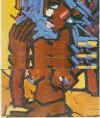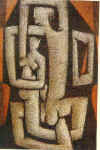|
|
||||
|
Cover Story
Art & Architecture
Archaeology
Travel
Feature
Health
Sports
Music
Lifestyle & People
South Asian Memories
|
|
|
||
|
the-south-asian.com 7 August 2000 |
||||
|
Page 3 of 3
Modern Idiom in
Contemporary Pakistani Art By Nillofur Farrukh
The Modernists
Sadequain A rare visionary, Sadequain was able to bridge the gulf between the disparate groups in society. At the age of 31 his work won recognition at the 1961 Paris Biennial. Sadequain had a prolific career and much of his work is displayed in public places. Like Diego Rivera, he celebrated the role of the proletariat. His early mural, based on the dignity of labour is housed in the Mangla dam, near Islamabad. Later he painted a mammoth ceiling for The Lahore Museum based on poet Iqbal’s verses evoking the spirit of man to triumph over odds. While working on his second ceiling at the Freer Hall in Karachi, the painter took ill and died leaving the work incomplete. During his life Sadequain became a cult figure with a large following from all walks of life. Elongated human forms with bleeding pen-like fingers and nest-shaped head were central to his imagery. In the 70s he got nation-wide fame for his rendering of Quranic verses. Sadequain was one of the few artists who continuously received State support and was equally admired by the people. The very work that gave him a large following did not get critical acclaim. Despite the divided opinion, his influential position in art history cannot be denied. He came from a long line of master calligraphers and was perhaps ideally suited to bridge the gap between modernity and tradition. The content of his work has wider appeal, the early works addressed social evils and in the later decades Sadequain used the unifying spirit of calligraphy to appeal to the masses, who came in large numbers to see his exhibitions. Shakir Ali Shakir Ali held sway over the Pakistani modernists for two decades, both with his work and his disposition. He was among the privileged few of his generation of painters who had firsthand experience of Modern Art in Paris. After studying art at J.J. School of Art, he attended Slade School in London, then worked in Paris with Andre L’Hote before he went to Prague. Shakir Ali began with a cubist preference and many of his themes borrowed from classical European myths like ‘Europa and the Bull’ and ‘Leda and the Swan’. As his style evolved, he pared down the human form to sharp angles and took up red as a dominant colour. Many of his paintings feature birds, which he looked upon as the symbol of personal freedom in a world of conventions. He did some pioneering work in Arabic calligraphy in the 60s, in which the alphabetic form is used as a linear design using colour and visual rhythm to lend it a modern interpretation. Bashir Mirza Bashir Mirza, a student of Shakir Ali, made a name with his pen and ink series of portraits of the common folk of Pakistan. He was also responsible for setting up the first private gallery in Karachi. His Lonely Girl series were completed and exhibited in the 70s and won him a permanent place in Pakistan’s art history. Bashir Mirza always treated drawing as a separate discipline which gave his painting and drawings a singular character. He became the only artist to turn into a diplomat when he was sent as a cultural attaché to Australia. Gifted with an intuitive sense of design and colour, central to his oeuvre is the female form with a colour field for a backdrop. At different periods of his career the style has varied. In the Lonely Girl, each smooth layer of colour blends into the other in gentle tones. In his Acrylic Series almost a textural violence takes place as bold expressionistic strokes clash and craft images. Jamil Naqsh Jamil Naqsh studied miniature at NCA but turned to modernism after his exposure to Shakir Ali’s early cubist paintings. Naqsh, a consummate draughtsman, began to paint nudes to which he added pigeons in subsequent years and this became the topic of his visual treatise. In the 70s his technique was redolent of pointillism, today he prefers to work with acrylics on paper with skilful washes creating images from multi-faceted planes. Leila Shahzada Primarily self-taught, Leila Shahzada’s oeuvre resonates with the surrealistic. Her Driftmood Series which introduced her as a serious talent were inspired by the shapes of driftwood found on the beaches of Karachi, which the painter’s inner vision had turned into flame like shapes. Later as her interest in mysticism grew she appropriated images from ancient Indus valley and Taxila. Before her accidental death in 1986, Shahzada had been working on a series of mountain landscapes, which displayed a latent surreal quality. Colin David Op Art served as a visual device in Colin David’s paintings. The black and white background design with its linear optical illusion forms an ever-changing relationship with the form, which was either a nude or clothed figure. It is always the dynamic ‘patterned’ space rather than the form that holds the interest of the viewer. The nude became the painter’s forte and in later series it was set against verdant landscapes. In the early post 1947 decades the artist adopted Modernism not as perpetuation of the First World hegemony but as a metaphor for change and economic freedom. In Pakistan the painters frequently borrowed classicised images of miniature paintings like Picasso did from Greek art and synthesized it with the grammar of modernism. Even if a European painter inspired them, it remained as a point of departure. The modernism that emerged in this region is not a derivative art but a stylistic adaptation used to articulate the experiences of a society in flux and in need for a dynamic expression. It was the first generation, taught by the pioneer modernists that initiated a break from the straitjacket of formalism to deal with the reality of their lived experiences. The society was no longer being viewed in stereotypes or idealised images, but as an evolving nation faced with the challenges of transition, from a colony to a democracy. _______________________
|
||||
| Copyright © 2000 [the-south-asian.com]. Intellectual Property. All rights reserved. | ||||


